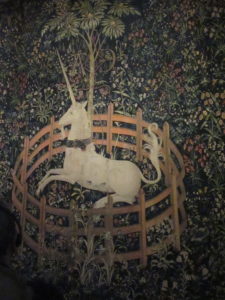The Cloisters
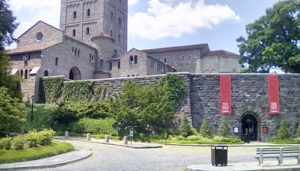 The Cloisters, a branch of the Metropolitan Museum of Art located within Fort Tryon Park on the northern tip of Manhattan, is a beautiful collection of medieval art and architecture. The core of the collection was put together by an American sculpture named George Grey Barnard in the early 1900s. The collection was later bought by John D. Rockefeller Jr, who donated it to the Met, along with the park lands and the building he had designed and constructed to hold the collection.
The Cloisters, a branch of the Metropolitan Museum of Art located within Fort Tryon Park on the northern tip of Manhattan, is a beautiful collection of medieval art and architecture. The core of the collection was put together by an American sculpture named George Grey Barnard in the early 1900s. The collection was later bought by John D. Rockefeller Jr, who donated it to the Met, along with the park lands and the building he had designed and constructed to hold the collection.
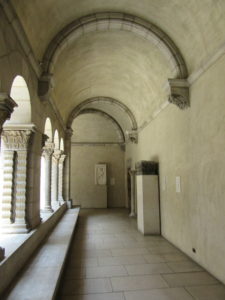 What is housed within this beautiful building are portions of four separate cloistered communities from southern France. A cloister is a covered or enclosed walkway attached to a house of worship. The term can also mean the group of monks or nuns that are enclosed or attached to the church or religious order or community. Also included in the Cloisters is a fine collection of tapestries, including the famous Unicorn Tapestry series, as well as paintings, stained glass pieces, alter pieces, and a wide variety of other medieval artifacts.
What is housed within this beautiful building are portions of four separate cloistered communities from southern France. A cloister is a covered or enclosed walkway attached to a house of worship. The term can also mean the group of monks or nuns that are enclosed or attached to the church or religious order or community. Also included in the Cloisters is a fine collection of tapestries, including the famous Unicorn Tapestry series, as well as paintings, stained glass pieces, alter pieces, and a wide variety of other medieval artifacts.
The place is enchanting. As you walk through each room, surprises and images flood your eyes. I have previously written here of my interest in the religious life, and here I was able to experience a piece of it for myself. I walked the corridors, I sat in the re-created chapter house rooms, I imagined what it would be like to live and worship within these walls.
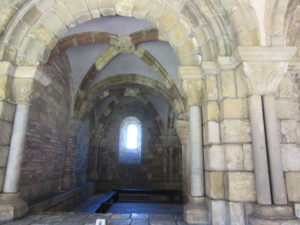
Chapter house, showing example of a quadripartite vaulted ceiling. Originally from the Cistercian abbey of Notre-Dame at Pontaut, south of Bordeaux. 12th century
Where else am I going to see and experience medieval architecture this close to home. Traveling to thirteenth century France this summer was beyond my budget or ability, but I could experience a little piece of it. I could sit in this chapter house and imagine myself as a cloistered religious figure embarking on house business.
The main character of my WIP is a stonemason from sixteenth century England. While he worked on domestic architecture and not religious buildings, there is enough similarity that I could imagine his hands carvings some of these beautiful detailed pieces, creating the fluid lines, the plays of light and shadow down walls and corridors. I was in heaven.
The beauty to me is that someone did carve these walls, effigies or alters. And even though they were created over 700 years ago, they still exist and are being enjoyed today. That’s a legacy.
Another collection I was particularly anticipating were the “Hunt of the Unicorn” tapestries, a series of seven hangings depicting a hunt for this famous mythical creature. There is a story in these hangings, their creation, their early history. And much of this story is unknown. I am intrigued by the letters (A & E) included in many of the panels and the various symbols to be found. So intrigued that these tapestries are now inspiring a new story I am in the process of deciphering and retelling.
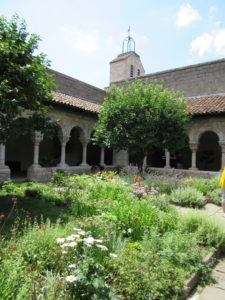 Finally, within the center of the building is a garden, typical of what might have been found at a monastery, which houses a variety of medieval plant species. The warmth of the sun and open air is complemented by the shade of the attached corridors.
Finally, within the center of the building is a garden, typical of what might have been found at a monastery, which houses a variety of medieval plant species. The warmth of the sun and open air is complemented by the shade of the attached corridors.
I thoroughly enjoyed my visit to The Cloisters and my family was generous enough to let me meander and study and experience for several hours. We picnicked on a nearby bench in Fort Tryon Park, overlooking the Hudson River and gazing across at the Palisades on the other side. It was a lovely day and I am still embracing the experience. If you get the chance to visit this delightful place, take it.

